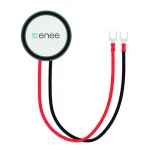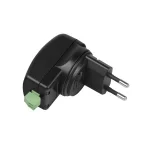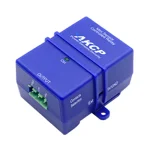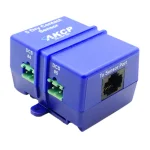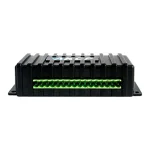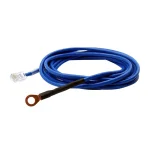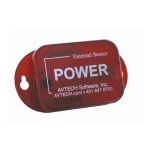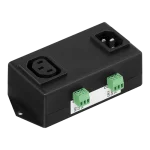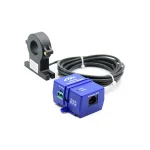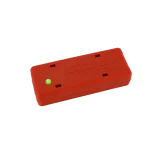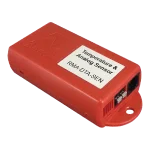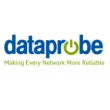Current sensors in the form of current loops or current clamps are sensors through which a power cord is run. The loop and clamp is in two parts and attaches around the cable to be measured. The current passing through the cable is measured using induction to generate a value in Amps of the power being drawn by the connected load. The current sensor is connected to an base environment monitoring device which acts as central point for data collection. Monitoring software is used to analyse the data and trigger an alarm notification outside threshold settings.
Server Room Power Monitoring
Monitoring power usage within a server room is essential for effective capacity planning and preventing potential overloads and nuisance breaker tripping. Power can be monitored at various levels, including branch circuits, wall power sockets, power outlets (PDUs), and within server racksand cabinets. Additionally, critical power components such as uninterruptible power supplies, generators, batteries, and energy storage systems can be monitored to ensure optimal performance. Each sensor, detector, and converter must be connected to a monitoring base unit as part of a comprehensive environment monitoring system for effective data centre power monitoring and server room power monitoring.
-
Applications (40)
- Temperature & Humidity (30)
- Water Leakage Detection (26)
- Server Rack Monitoring (28)
- Hardwired Ethernet Devices (28)
- Wi-Fi Connectivity Units (8)
- Wireless Devices (12)
- Narrowband IoT Devices (4)
- GSM / LTE Comms (7)
- Battery Monitoring (7)
- Power Monitors (28)
- Security Monitors (26)
- Branch Circuits (2)
- Data Centres (7)
- Data Loggers (11)
- Data Aquisition Systems (11)
- Laboratories (18)
- Pharmaceutical (18)
- Sensors (140)
- Accessories (160)
Data Centre Power Monitoring
The path within a data centre from the building incomer to the IT loads is referred to as the critical power path. It is important to be able to monitor power consumption and energy efficiency along the critical power path to ensure that the data centre is operating within its specification in terms of power usage (kW) and energy efficiency. Data centre power monitoring also helps with capacity planning as the number of server cabinets, servers and IT devices are increased.
Hardware solutions within the critical power path include LV switchboards, uninterruptible power supplies and power distribution units. Each of these solutions will have some form of built-in power monitoring. Information may be available locally via built-in displays and meters, and remotely via SNMP and communications interfaces. When there is a power outage, alarms may also be generated and reported remotely.
Monitoring power quality can also help to extend the working life of servers and IT devices installed within a data centre environment. Installing some form of power protection from spikes, sags, surges, brownouts, and harmonics which can all place electrical stress on power supplies will typically help to extend their working life. Typical examples include surge suppression devices, voltage stabilisers, isolation transformers and UPS systems.
Server room power monitoring solutions can be installed to monitor power usage within the room, server rack or at the power distribution unit outlet level. By monitoring power usage, overloads can be avoided, and additional capacity safely added to an existing section of the critical power path.
Benefits of Server Room Power Monitoring
A server room provides a managed and secure environment in which an organisation houses and operates its critical IT servers. Monitoring power usage helps to improve uptime, capacity planning and energy efficiency. The main benefits of server room power monitoring include:
- Energy Management: a power monitoring system allows you to control and manage your energy consumption. Energy usage monitoring can help to identify where energy savings can be made by providing real-time performance data. High energy usage can be investigated, and the root cause identified. A typical example is a poorly installed or undersized cooling system and/or hot spots within the server room
- Server Power Management: monitoring load capacities and power usage can identify under utilised servers and other assets that could be powered down remotely and restarted when capacity demands reach a specific level.
- Electrical System Monitoring: monitoring electrical power usage can lead to improved electrical safety. Overloaded circuits (A/B) could be identified leading a safer distribution of the loads across corresponding circuits to prevent upstream breakers tripping. Overheating can also be a sign that a hardware element within the critical power path requires further analysis.
- Server Room Equipment Protection: changes in temperature and humidity can be monitored using sensors connected to an environment monitoring system. Power supply availability, amps, voltage, and energy usage in kWh can also be monitored as can alarms from detectors for smoke, fire and cabinet door access.
- Power Efficiency: electricity costs continue to rise and the high the energy efficiency in a server room or data centre, the lower the total cost of ownership and operating costs. Power monitoring can identify areas for further investigation and lead to a replacement of legacy cooling and UPS systems with the latest more energy efficient products.
Smart Power Monitoring Products
For an alternative power and energy monitoring solution see our range of Smart Power Devices including in-line energy meters that can be monitored over WiFi and Cloud connections, smart PDUs and power strips.

Earn SRE points on all online purchases with double points on selected products





























